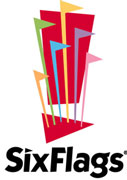
Vol. IV, No. 7, July 2004
- Editor's Corner
- Americans Moving to Enriching & Social Experiences
- Last Chance to Attend Foundations Entertainment University
- Chuck E. Cheese Gets Pie'd
- Theme Park Economics
- Looking for a Seminar on Edutainment?
- Reality Restaurant Video Game
- Who Administers ADA?
- 100th Anniversary of the Hamburger
- EM-Newsletter
- Two Strikes and You're Out!
- New Lighthouse Menu at Red Lobster
- Targeting Socio-Economic/Lifestyle Groups
- So Much Information!
- Whac-A-Moles on the Loose
- New Projects
Theme Park Economics
Our consulting, design and production business and this eNewsletter are both focused on neighborhood- and community-based leisure facilities, not regional attractions such as theme parks. However, we thought it would be interesting to take a look at the big boys, the theme parks, just to see if the grass is greener on their side of the fence.
 Six
Flags, Inc. operated 39 theme parks and waterparks throughout the world
in 2003. We obtained their 2003 financial statements and did some analysis.
Here's what we found.
Six
Flags, Inc. operated 39 theme parks and waterparks throughout the world
in 2003. We obtained their 2003 financial statements and did some analysis.
Here's what we found.
Each park, on average, had an annual attendance of 1,070,000. That's a lot of bodies, especially between Memorial Day and Labor Day when they do 85% of their business. Annual revenues per park were $31.7 million. That works out to per capita revenue of $29.84 a guest. Admissions generated 55% of revenues and food, merchandise and miscellaneous sales, 45%.
Ever wonder about the expensive food and merchandise you find in theme parks? The explanation is real simple. The price is marked up far more over cost than at restaurants or retail stores. Six Flags' cost of goods sold for food, merchandise and other, which would include things such as that photograph showing your horrified facial expression as the roller coaster roars down the track, was only 18.2%. That's at least 1/3 less than for businesses found outside a theme park, meaning the theme park markup is at least 50% greater, and in many cases probably more than twice a normal mark-up.
Getting an average of over 1.0 million people to show up each season to their theme parks is impressive. However, Six Flags is spending a lot of money on marketing to accomplish it - 11.2% of revenues to be exact. That's two to three times the percentage that most community destination entertainment facilities have to spend. If Six Flags has to spend so much to keep attracting guests to come through the gate, it makes you wonder if theme parks really offer such a great value.
How profitable are theme parks? In 2003, Six Flags had an EBITDA (earnings before interest, taxes, depreciation and amortization), which in their case is effectively cash flow from operations, of 30.2% of revenues. That's good!
But here's where things don't look so good. On average, Six Flags had $120 million of assets after depreciation and amortization invested in each park. When you compare that to their average EBITDA per park of $9.6 million, they only had an 8% return on assets. That's lousy and much less than what a successful community-based entertainment center, such as an FEC or children's edutainment center, would return if the business investment included the land and buildings, as Six Flags does. In fact, Six Flags' cost of borrowing of 7.7% is practically the same as the 8% return, making the situation even worse, since their return on assets is not being leveraged by borrowing.
It doesn't look like the grass is greener on the other side of the fence in the theme park industry. In fact the grass is pretty dry and brown. So unless you have some passion for roller coasters and are about to inherit mega bucks, stick to community-based leisure. The projects might be smaller, but the return on investment is far greater.
Vol. IV, No. 7, July 2004
- Editor's Corner
- Americans Moving to Enriching & Social Experiences
- Last Chance to Attend Foundations Entertainment University
- Chuck E. Cheese Gets Pie'd
- Theme Park Economics
- Looking for a Seminar on Edutainment?
- Reality Restaurant Video Game
- Who Administers ADA?
- 100th Anniversary of the Hamburger
- EM-Newsletter
- Two Strikes and You're Out!
- New Lighthouse Menu at Red Lobster
- Targeting Socio-Economic/Lifestyle Groups
- So Much Information!
- Whac-A-Moles on the Loose
- New Projects


